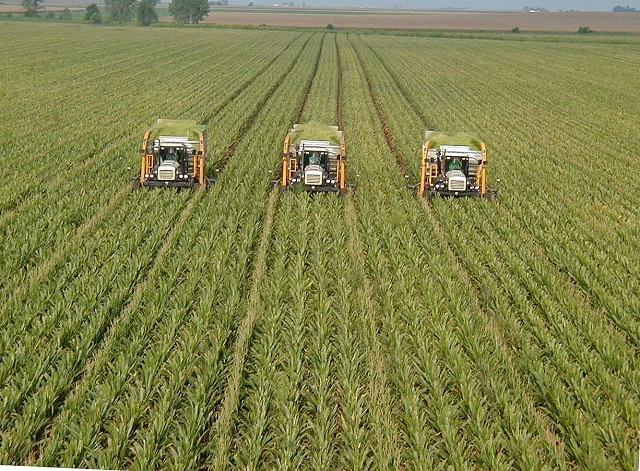Experts propose Pak-China agri-council | The Express Tribune
Experts propose Pak-China agri-council The Express Tribune


Experts Call for Pakistan-China Council on Agricultural Development under CPEC

ISLAMABAD:
Experts at a policy dialogue have demanded that a Pakistan-China council on agricultural development, led by the private sector of both countries, should be set up with focus on technology transfer and capacity building of Pakistani farmers in modern technologies under the China-Pakistan Economic Corridor (CPEC).
The policy dialogue was arranged by the Sustainable Development Policy Institute (SDPI) on the topic of “Greening of the CPEC: Sustainable Agriculture in Pakistan and Learning from China” on Friday.
Former CPEC project director and former Khyber-Pakhtunkhwa Board of Investment CEO Dr Hassan Daud Butt said the future of agricultural production and food security relied on technology advancement, good policies and the leadership.
However, it is pertinent to establish a council for agricultural development, led by the private sector and while forging linkages with Chinese counterparts, which will help achieve targets swiftly.
He emphasised that China had made massive progress in the field of agriculture through consistent policies, leadership and technology-driven interventions.
Butt pointed out that China’s progress in the agriculture sector was unique as less public capital and more private investment were utilised for its development.
“Pakistan needs to learn from the Chinese about planning for short, medium and long-term goals with a top-to-bottom approach and policy consistency. Moreover, the leadership in the public and private sectors needs to be strengthened through mutual collaboration,” he said.
Lessons from China for Sustainable Agricultural Development in Pakistan
While the SDPI’s study was based on sustainable agricultural development via lessons learnt from China, he urged authors of the report to add livestock as a component to further broaden the scope with insights on marketing aspects as well.
Scoping Study on Agriculture Development in Pakistan
- Establish a Pakistan-China council on agricultural development
- Focus on technology transfer and capacity building of Pakistani farmers
- Private sector-led collaboration with Chinese counterparts
- Learn from Chinese experience in planning and policy consistency
- Strengthen leadership in public and private sectors through mutual collaboration
Published in The Express Tribune, May 11th, 2024.
Like Business on Facebook, follow @TribuneBiz on Twitter to stay informed and join in the conversation.
SDGs, Targets, and Indicators in the Article
-
SDG 2: Zero Hunger
- Target 2.3: By 2030, double the agricultural productivity and incomes of small-scale food producers, in particular women, indigenous peoples, family farmers, pastoralists, and fishers, including through secure and equal access to land, other productive resources and inputs, knowledge, financial services, markets, and opportunities for value addition and non-farm employment.
- Indicator 2.3.1: Volume of production per labor unit by classes of farming/pastoral/forestry enterprise size.
-
SDG 9: Industry, Innovation, and Infrastructure
- Target 9.5: Enhance scientific research, upgrade the technological capabilities of industrial sectors in all countries, in particular developing countries, including, by 2030, encouraging innovation and substantially increasing the number of research and development workers per 1 million people and public and private research and development spending.
- Indicator 9.5.1: Research and development expenditure as a proportion of GDP.
-
SDG 17: Partnerships for the Goals
- Target 17.6: Enhance North-South, South-South, and triangular regional and international cooperation on and access to science, technology, and innovation and enhance knowledge sharing on mutually agreed terms, including through improved coordination among existing mechanisms, particularly at the United Nations level, and through a global technology facilitation mechanism.
- Indicator 17.6.1: Number of science and/or technology cooperation agreements and programmes between countries, by type of cooperation.
Explanation of Findings
SDG 2: Zero Hunger
The article highlights the importance of technology transfer and capacity building for Pakistani farmers in modern agricultural practices. This aligns with SDG 2, which aims to achieve zero hunger and improve agricultural productivity. The target identified in the article is Target 2.3, which focuses on doubling the agricultural productivity and incomes of small-scale food producers. The indicator mentioned is Indicator 2.3.1, which measures the volume of production per labor unit by classes of farming/pastoral/forestry enterprise size.
SDG 9: Industry, Innovation, and Infrastructure
The article emphasizes the need for technology advancement and innovation in the agricultural sector. This relates to SDG 9, which aims to promote sustainable industrialization and foster innovation. The target identified in the article is Target 9.5, which focuses on enhancing scientific research and technological capabilities. The indicator mentioned is Indicator 9.5.1, which measures research and development expenditure as a proportion of GDP.
SDG 17: Partnerships for the Goals
The article calls for the establishment of a council for agricultural development, led by the private sector and in collaboration with Chinese counterparts. This aligns with SDG 17, which focuses on strengthening partnerships for sustainable development. The target identified in the article is Target 17.6, which aims to enhance international cooperation on science, technology, and innovation. The indicator mentioned is Indicator 17.6.1, which measures the number of science and/or technology cooperation agreements and programs between countries.
Table: SDGs, Targets, and Indicators
| SDGs | Targets | Indicators |
|---|---|---|
| SDG 2: Zero Hunger | Target 2.3: By 2030, double the agricultural productivity and incomes of small-scale food producers, in particular women, indigenous peoples, family farmers, pastoralists, and fishers, including through secure and equal access to land, other productive resources and inputs, knowledge, financial services, markets, and opportunities for value addition and non-farm employment. | Indicator 2.3.1: Volume of production per labor unit by classes of farming/pastoral/forestry enterprise size. |
| SDG 9: Industry, Innovation, and Infrastructure | Target 9.5: Enhance scientific research, upgrade the technological capabilities of industrial sectors in all countries, in particular developing countries, including, by 2030, encouraging innovation and substantially increasing the number of research and development workers per 1 million people and public and private research and development spending. | Indicator 9.5.1: Research and development expenditure as a proportion of GDP. |
| SDG 17: Partnerships for the Goals | Target 17.6: Enhance North-South, South-South, and triangular regional and international cooperation on and access to science, technology, and innovation and enhance knowledge sharing on mutually agreed terms, including through improved coordination among existing mechanisms, particularly at the United Nations level, and through a global technology facilitation mechanism. | Indicator 17.6.1: Number of science and/or technology cooperation agreements and programs between countries, by type of cooperation. |
Copyright: Dive into this article, curated with care by SDG Investors Inc. Our advanced AI technology searches through vast amounts of data to spotlight how we are all moving forward with the Sustainable Development Goals. While we own the rights to this content, we invite you to share it to help spread knowledge and spark action on the SDGs.
Fuente: tribune.com.pk

Join us, as fellow seekers of change, on a transformative journey at https://sdgtalks.ai/welcome, where you can become a member and actively contribute to shaping a brighter future.







